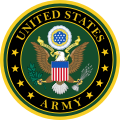| U.S. Army Intelligence and Security Command | |
|---|---|
 INSCOM Shoulder Sleeve Insignia | |
| Active | 1977–present |
| Country | |
| Branch | |
| Type | Direct reporting unit [ broken anchor ] |
| Role | Military intelligence, Information operations |
| Size | 10,000+ [1] |
| Part of | Army Cyber Command |
| Headquarters | Fort Belvoir, Virginia |
| Nickname(s) | INSCOM |
| Website | Official website |
| Commanders | |
| Current commander | MG Timothy D. Brown |
| Chief Warrant Officer | CW5 Jeremy M. Sager |
| Command Sergeant Major | CSM Anthony Rangel III |
| Insignia | |
| INSCOM Seal |  |
| Distinctive unit insignia |  |
The United States Army Intelligence and Security Command (INSCOM) is a direct reporting unit that conducts intelligence, security, and information operations for United States Army commanders, partners in the Intelligence Community, and national decision-makers. INSCOM is headquartered at Fort Belvoir, Virginia.
Contents
- Mission
- Structure
- History
- Merger and creation of INSCOM
- Parapsychologic research
- In caselaw
- List of commanding generals
- References
- External links
INSCOM contributes units to the National Security Agency, the United States's unified signals intelligence (SIGINT) organization. Within the NSA, INSCOM and its counterparts in the Navy, Air Force, Space Force, Coast Guard, and Marine Corps comprise the Central Security Service. INSCOM's budget has been estimated to be approximately $6 billion. [2]
As a direct reporting unit, INSCOM reports directly to the chief of staff of the Army.











